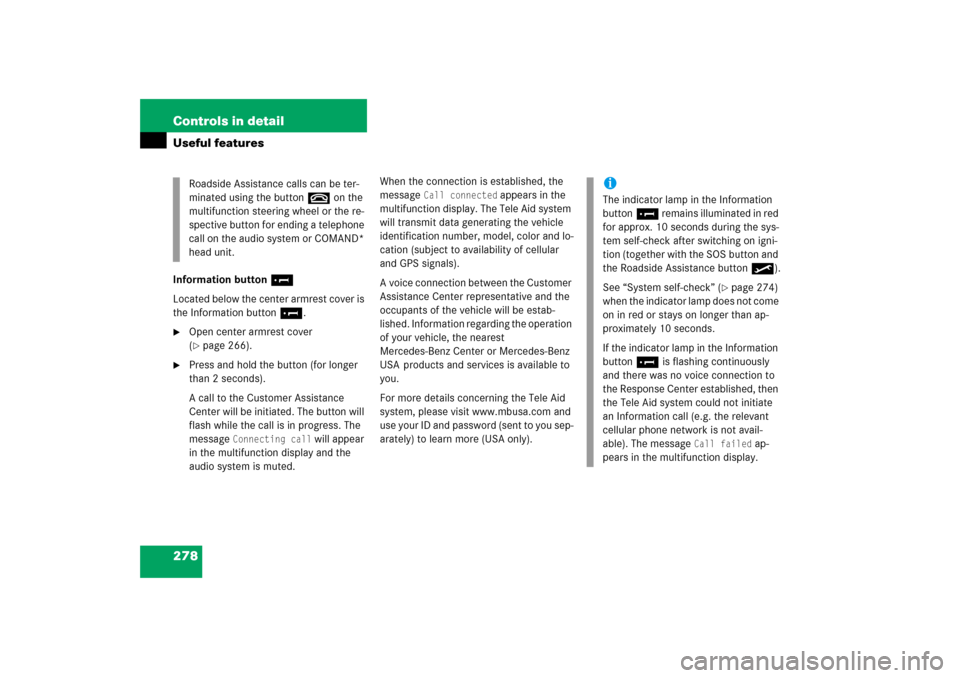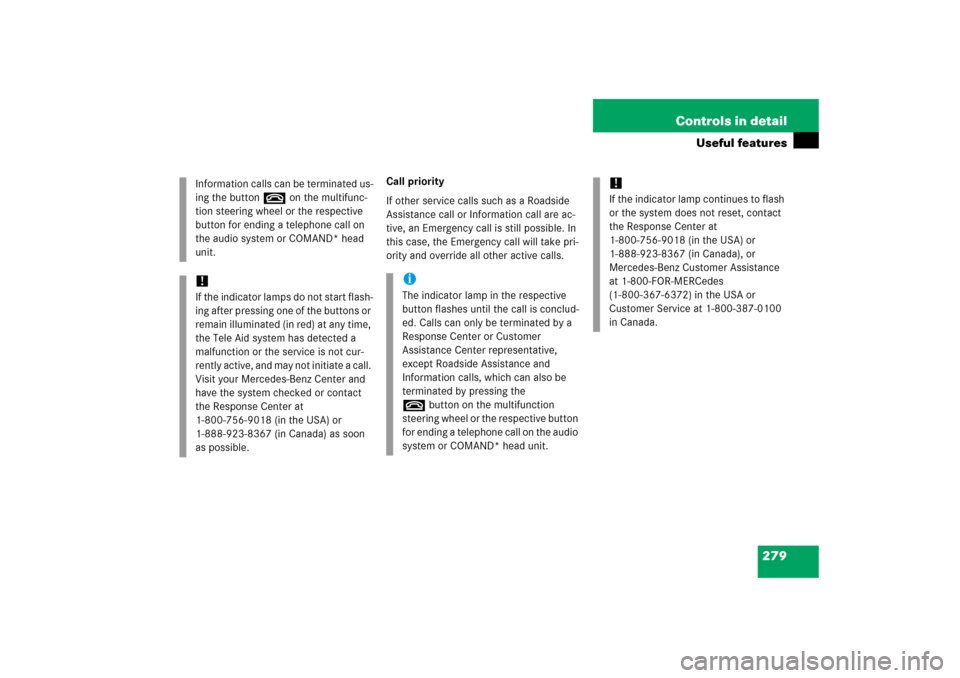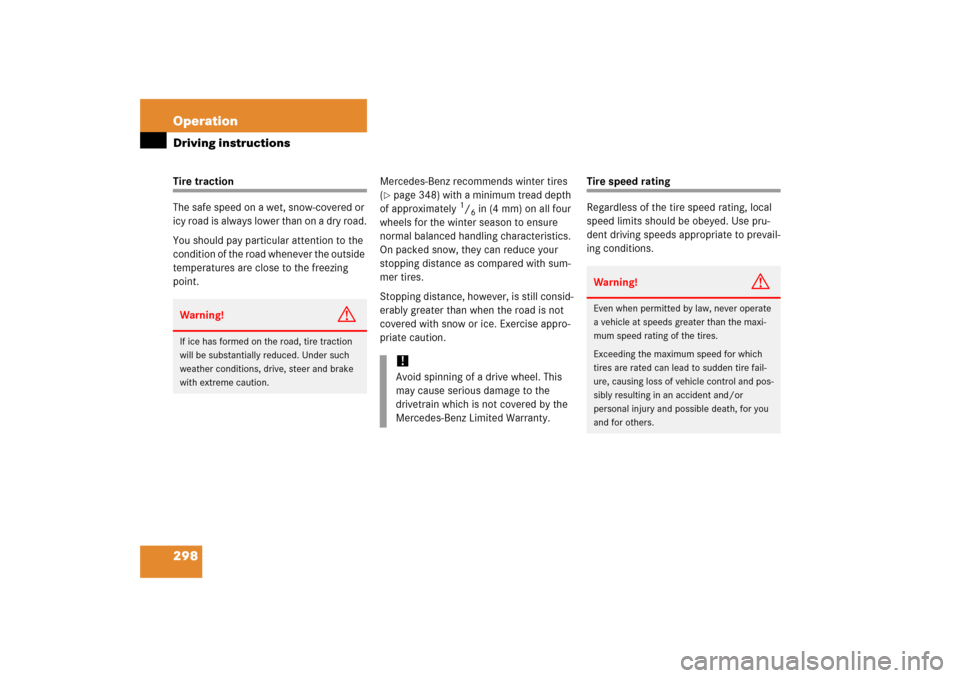Page 279 of 481

278 Controls in detailUseful featuresInformation button¡
Located below the center armrest cover is
the Information button¡.�
Open center armrest cover
(�page 266).
�
Press and hold the button (for longer
than 2 seconds).
A call to the Customer Assistance
Center will be initiated. The button will
flash while the call is in progress. The
message
Connecting call
will appear
in the multifunction display and the
audio system is muted.When the connection is established, the
message
Call connected
appears in the
multifunction display. The Tele Aid system
will transmit data generating the vehicle
identification number, model, color and lo-
cation (subject to availability of cellular
and GPS signals).
A voice connection between the Customer
Assistance Center representative and the
occupants of the vehicle will be estab-
lished. Information regarding the operation
of your vehicle, the nearest
Mercedes-Benz Center or Mercedes-Benz
USA products and services is available to
you.
For more details concerning the Tele Aid
system, please visit www.mbusa.com and
use your ID and password (sent to you sep-
arately) to learn more (USA only). Roadside Assistance calls can be ter-
minated using the buttont on the
multifunction steering wheel or the re-
spective button for ending a telephone
call on the audio system or COMAND*
head unit.
iThe indicator lamp in the Information
button¡ remains illuminated in red
for approx. 10 seconds during the sys-
tem self-check after switching on igni-
tion (together with the SOS button and
the Roadside Assistance button•).
See “System self-check” (
�page 274)
when the indicator lamp does not come
on in red or stays on longer than ap-
proximately 10 seconds.
If the indicator lamp in the Information
button¡ is flashing continuously
and there was no voice connection to
the Response Center established, then
the Tele Aid system could not initiate
an Information call (e.g. the relevant
cellular phone network is not avail-
able). The message
Call failed
ap-
pears in the multifunction display.
Page 280 of 481

279 Controls in detail
Useful features
Call priority
If other service calls such as a Roadside
Assistance call or Information call are ac-
tive, an Emergency call is still possible. In
this case, the Emergency call will take pri-
ority and override all other active calls. Information calls can be terminated us-
ing the buttont on the multifunc-
tion steering wheel or the respective
button for ending a telephone call on
the audio system or COMAND* head
unit.
!If the indicator lamps do not start flash-
ing after pressing one of the buttons or
remain illuminated (in red) at any time,
the Tele Aid system has detected a
malfunction or the service is not cur-
rently active, and may not initiate a call.
Visit your Mercedes-Benz Center and
have the system checked or contact
the Response Center at
1-800-756-9018 (in the USA) or
1-888-923-8367 (in Canada) as soon
as possible.
iThe indicator lamp in the respective
button flashes until the call is conclud-
ed. Calls can only be terminated by a
Response Center or Customer
Assistance Center representative,
except Roadside Assistance and
Information calls, which can also be
terminated by pressing the
tbutton on the multifunction
steering wheel or the respective button
for ending a telephone call on the audio
system or COMAND* head unit.
!If the indicator lamp continues to flash
or the system does not reset, contact
the Response Center at
1-800-756-9018 (in the USA) or
1-888-923-8367 (in Canada), or
Mercedes-Benz Customer Assistance
at 1-800-FOR-MERCedes
(1-800-367-6372) in the USA or
Customer Service at 1-800-387-0100
in Canada.
Page 289 of 481

288 Controls in detailUseful features
Heated steering wheel* (SLK 280, SLK 350, Canada only)
The steering wheel heating warms up the
leather area of the steering wheel.
The lever is on the lower left-hand side of
the steering wheel.
1Switching on
2Indicator lamp
3Switching offSwitching on
�
Switch on the ignition (
�page 36).
�
Turn switch at tip of lever in direction of
arrow1 and release it.
The steering wheel is heated. Indicator
lamp2 comes on.
iCanada only:
This device complies with RSS-210 of
Industry Canada. Operation is subject
to the following two conditions:
(1) This device may not cause interfer-
ence, and
(2) this device must accept any inter-
ference received, including interfer-
ence that may cause undesired
operation of the device.
Any unauthorized modification to this
device could void the user’s authority
to operate the equipment.
iThe steering wheel heating is tempo-
rarily suspended while indicator
lamp2 remains on when�
the temperature of the vehicle inte-
rior is above 86°F (30°C)
�
the temperature of the steering
wheel is above 95°F (35°C)
When these conditions do not apply
anymore, steering wheel heating con-
tinues.
Page 290 of 481
289 Controls in detail
Useful features
Switching off�
Turn switch at tip of lever in direction of
arrow3 and release it.
The steering wheel heating is switched
off. Indicator lamp2 goes out.iIndicator lamp2 flashes or switches
off in case of�
power surge or undervoltage
�
steering wheel heating malfunction
iThe steering wheel heating switches off
automatically when you remove the
SmartKey from the starter switch.
Page 292 of 481
291 Operation
The first 1 000 miles (1 500 km)
Driving instructions
At the gas station
Engine compartment
Tires and wheels
Winter driving
Maintenance
Vehicle care
Page 297 of 481

296 OperationDriving instructionsDriving off
Apply the brakes to test them briefly after
driving off. Perform this procedure only
when the road is clear of other traffic.
Warm up the engine smoothly. Do not
place full load on the engine until the oper-
ating temperature has been reached.
When starting off on a slippery surface, do
not allow a drive wheel to spin for an ex-
tended period with the ESP
® switched off.
Doing so may cause serious damage to the
drivetrain which is not covered by the
Mercedes-Benz Limited Warranty.
Parking
!Simultaneously depressing the acceler-
ator pedal and applying the brake re-
duces engine performance and causes
premature brake and drivetrain wear.
Warning!
G
Do not park this vehicle in areas where com-
bustible materials such as grass, hay or
leaves can come into contact with the hot
exhaust system, as these materials could be
ignited and cause a vehicle fire.
To reduce the risk of personal injury as a re-
sult of vehicle movement, before
turning off
the engine and leaving the vehicle always:
�
Keep right foot on brake pedal.
�
Pull the parking brake lever up as many
notches as possible.
�
Move the selector lever to positionP
(manual transmission: first or reverse
gear).
�
Slowly release brake pedal.
�
When parked on an incline, turn front
wheels towards the road curb.
�
Turn the SmartKey in the starter switch
to position0 and remove the SmartKey
from the starter switch.
�
Take the SmartKey and lock vehicle
when leaving.!Set the parking brake whenever park-
ing or leaving the vehicle. In addition,
place gear selector lever* in positionP
(manual transmission: move gearshift
lever to first or reverse gear).
In addition, when parking on hills, turn
front wheel towards the road curb.
Page 299 of 481

298 OperationDriving instructionsTire traction
The safe speed on a wet, snow-covered or
icy road is always lower than on a dry road.
You should pay particular attention to the
condition of the road whenever the outside
temperatures are close to the freezing
point.Mercedes-Benz recommends winter tires
(
�page 348) with a minimum tread depth
of approximately
1/6in (4 mm) on all four
wheels for the winter season to ensure
normal balanced handling characteristics.
On packed snow, they can reduce your
stopping distance as compared with sum-
mer tires.
Stopping distance, however, is still consid-
erably greater than when the road is not
covered with snow or ice. Exercise appro-
priate caution.
Tire speed rating
Regardless of the tire speed rating, local
speed limits should be obeyed. Use pru-
dent driving speeds appropriate to prevail-
ing conditions.
Warning!
G
If ice has formed on the road, tire traction
will be substantially reduced. Under such
weather conditions, drive, steer and brake
with extreme caution.
!Avoid spinning of a drive wheel. This
may cause serious damage to the
drivetrain which is not covered by the
Mercedes-Benz Limited Warranty.
Warning!
G
Even when permitted by law, never operate
a vehicle at speeds greater than the maxi-
mum speed rating of the tires.
Exceeding the maximum speed for which
tires are rated can lead to sudden tire fail-
ure, causing loss of vehicle control and pos-
sibly resulting in an accident and/or
personal injury and possible death, for you
and for others.
Page 300 of 481

299 Operation
Driving instructions
SLK 280, SLK 350
SLK 280 with Sport Package*
SLK 350 with Sport Package*
Your vehicle is factory equipped with
“W”-rated tires, which have a tire speed
rating of 168 mph (270 km / h).
An electronic speed limiter prevents your
vehicle from exceeding a speed of
155 mph (250 km/h).
SLK 55 AMG
Your vehicle is factory equipped with
“Y”-rated tires, which have a tire speed
rating of 186 mph (300 km / h).
An electronic speed limiter prevents your
vehicle from exceeding a speed of
155 mph (250 km/h).SLK 55 AMG with Performance
Package*
Your vehicle is factory equipped with
“Y”-rated tires, which have a tire speed
rating of 186 mph (300 km / h).
An electronic speed limiter prevents your
vehicle from exceeding a speed of
174 mph (280 km/h).
Winter driving instructions
The most important rule for slippery or icy
roads is to drive sensibly and to avoid
abrupt acceleration, braking and steering
maneuvers. Do not use the cruise control
system under such conditions.
When the vehicle is in danger of skidding,
move gear selector lever* to positionN or
declutch in case of manual transmission.
Try to keep the vehicle under control by
corrective steering action.
iFor information on speed rating for
winter tires, see “Winter tires”
(�page 348).
For additional general information on
tire speed markings on tire sidewall,
see “Tire speed rating” (
�page 334).
iFor information on driving with snow
chains, see “Snow chains”
(�page 349).
Warning!
G
On slippery road surfaces, never downshift
in order to obtain braking action. This could
result in drive wheel slip and reduced vehi-
cle control. Your vehicle’s ABS will not pre-
vent this type of control loss.